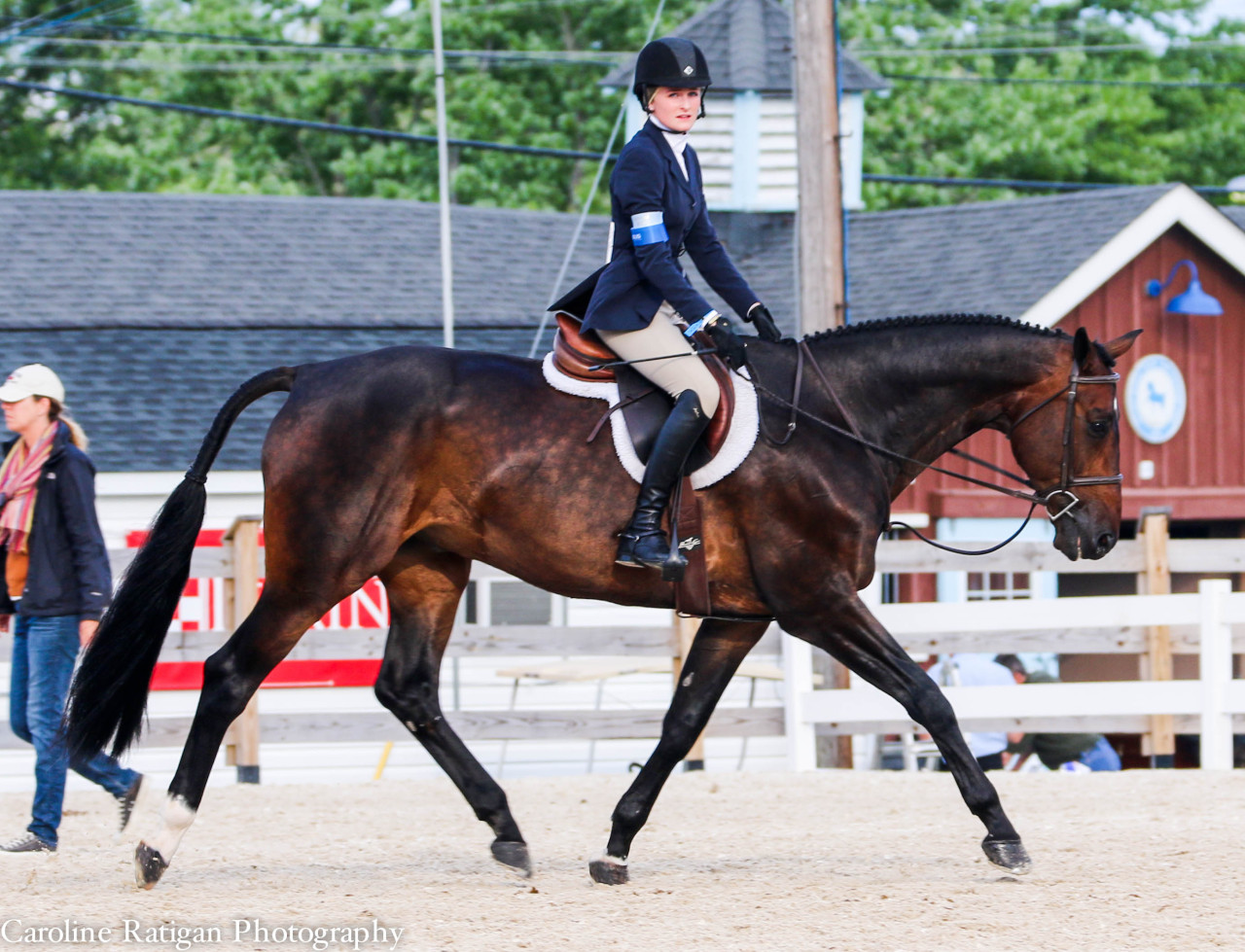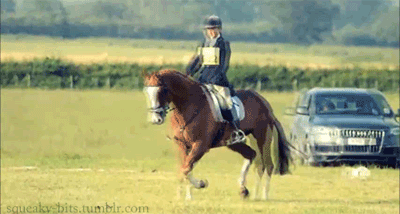This month I'll be doing a series on the rider at the trot - especially as my trainer has been getting after to me to practice my sitting trot more than I do. I'll be looking around for good off-the-horse exercises and applicable tips for mastering a better trot while riding.
Today I'm writing about the posting trot, or the rising trot, especially as this is a skill we all learn in our first month on horseback and inevitably have to revisit when we're improving our riding.
I'm writing from my own experiences as a trainer, so please keep in mind that at this point, I function largely as an entry-level eventing trainer. My students' posting trot needs to be controlled, effective, needs to match a variety of horses' power levels, and needs to allow them to feel the horse that they're riding.
Let's tear apart that sentence a bit, shall we?
Needs to be controlled
We've all seen those beginners who are absolutely getting launched out of the tack - whether it's their own riding or they are over-horsed, that post is uncontrolled. The first step to gain a controlled post is to practice posting at the walk. And not totally with abandon, I really want my riders to think about the mechanics of posting - to feel the tops of their thighs engage, to feel the tone in their core required to prevent the front of their body from lengthening, and to feel the knees stay in contact with the saddle without pinching.
It's a lot to ask, trust me, I know.
I like to see a thigh rotated inwards so that the adductor can rest gently against the saddle. I do not want to see air between the knee and the saddle, but at the same time I don't want the rider to be gripping for dear life with their knees. As they rise, the lower leg should not move. The rider's hips move forward and draw a small, quarter circle as they rise. I do not want a rider to land heavily in the saddle.
Once the rider has a bit more control over their body in their posting trot, I'll introduce the dancing trot. The dancing trot is also known as 'two ups, one down', or sometimes double posting. Instead of posting up and down with the 1-2 rhythm, you will stay up an extra beat. up-up-down-up-up-down. If your lower leg isn't secure underneath you or your legs are too stiff to act as springs, you will either fall forward or backward, revealing to you where your leg needs to be.
This exercise generally produces a too-forward angle in my rider's upper body, but I'll leave that alone for a little while as we increase the security of our legs. Next I have my riders practice the 7-7-7 (seven strides sitting, seven strides posting, seven strides half-seat), which allows us a lot of mobility in and around the saddle, all while securing our lower leg in place.
Once these exercises are easy, I can be reasonably certain the posting trot is controlled.
 |
| Danke Tumblr for filling in for my lack of photos |
Needs to be effective
Ah - effectiveness. What makes a posting trot ineffective? A posting trot is ineffective when the upper body and hands are unable to produce a half-halt, when pausing at the bottom of your rise fails to slow the horse, and when the horse is simply totally in control of the pace.
This pretty much comes down to engaging your core and having positive tension in your upper body.
Four major ways to increase the tone in your core loud enough for your instructor to hear? Cough, clear your throat, growl, or hiss. Try it now, at home. It's only a little as silly as you think it is, but it works.
Imagine pushing a broom. You naturally engage your core when you sweep. The problem about riding is that we don't generally naturally rely on supporting our upper body with our core, so we have to think about adding positive tension all the time because it leaks out of us.
When your upper body is stable, a half halt can be as easy as pausing in the saddle and closing your fingers for a moment. Heck yes, your horse has to know what that means, but even if he's green having a stronger core means that you actually can affect the way he's moving. No more pulling fights! This is, in my experience, the #2 reason a trainer can get on your horse and they instantly go differently. (#1 being that they have more experience with the nebulous feel, so they know what they're looking for and the path it takes to get there because they've traveled the path a LOT more than you have.)
 |
| Found on Tumblr, and holy dapples batman! Could totally be Tango.... if he weren't a thoroughbred... |
Needs to match different equine power levels
As a rider, your mechanic has to be so controlled that within a few beats of the trot you can match the power output of the horse you're riding. There are a few elements here: the tone in your thighs, your core (dammit, that again?), and the height of your post.
If you don't have enough tone in your thigh, then you're relying on gravity to help you post. When you only have tone on the up and then your thigh goes slack, you are not matching the power of your horse. On a small-moving horse, this doesn't matter at all (well it does really but I'm not getting into it here). On a bigger-moving horse, this lack of tone becomes immediately evident.
An exercise I'll do to help with the feel of this: while keeping your tempo precisely the same, how small can you post? Then how big can you post? The tempo must remain the same, meaning that you have to find a way to use your thigh as a lever and get control of your pelvis all the way to the top of your rise and all the way to the bottom.
A big part of learning to ride different horses and match them is keeping your torso even. No twisting through the ribcage as you rise or sit, and ESPECIALLY no lengthening the front of your body as you rise. You must keep the bottom of your ribcage down and your pelvis oriented with seatbones down, else you'll lose that very important core engagement. Another benefit of developing a stable, still upper body is that you clear the lines of communication with your horse. There's much less static, allowing your aids to be more effective and more easily understood.
Ultimately, the best way to match different horse's power output is to ride a lot of different horses, but if I've taught the mechanics well, generally riders can adapt well to all sorts of horses.
Needs to allow a sense of feel with the horse
This one takes more time to develop. But if you've really mastered the posting trot, you need to have an ever-expanding sense of feel with the horse. This means your thighs must rest against the horse without pinching - how else can you feel if your horse is breathing between your legs, or if his shoulder is about to move in an unexpected direction, or if he's nervous? This means that you settle softly into the saddle for a moment, allowing your seat bones to detect if your horse's back is up underneath you or if you are falling into the man-hole that develops from a hollow horse.
This also means your elbows are soft so that your shoulders can receive information about the horse's neck through his jaw. This also means that your position, while unyielding in its correctness, is soft and balanced and inviting to the horse's back. He can trust you, and you can influence him.
In conclusion
I could go on at length about the myriad asymmetries and unique variations I see on posting the trot, but I think I've covered the "basics" above. For a neat dressage posting vs hunter posting check out this blog post here, while I will add that balance is balance and when your stirrups are shorter, your upper body tends to incline forward, while when your stirrups are longer, you have to really fight to sit upright. Please let me know if there are any questions!
 | |||||
| Oh wait sorry were we talking about trotting? I wanted to give you a preview of the AMAZING photos E took of Kat & I yesterday... |



Great article!
ReplyDeleteThanks!
Deleteup-up-down posting is pretty much the bane of my existence haha. great pic of you and Kat - can't wait to see the rest too!
ReplyDeleteWhat is the most challenging part of up up downs to you?
Delete